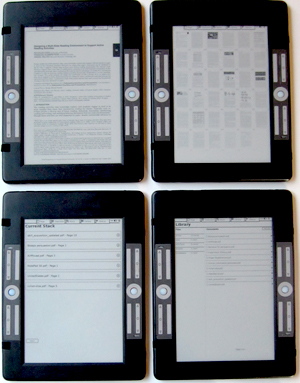E-text rivals paper in these 'United Slates'
By Bill Steele

If you’re reading a textbook, checking reference volumes, viewing online documents, compiling handwritten notes, flipping paper pages or marking text with a highlighter, you’re no longer a casual reader. Cross the border into new technology. Welcome to the “United Slates” – a digital age active-reading system using an array of tablets to combine the best features of paper and electronic text.
François Guimbretière, associate professor of information science, and Nicholas Chen, a former visiting researcher at Cornell now at Microsoft Research, developed the prototype system. Chen will demonstrate the system and describe tests with Cornell graduate students at the ACM SIGCHI Conference on Human Factors in Computing Systems in Paris April 27-May 2.
“The goal is not so much to change how people read, but to create a system that enhances existing reading practice,” Chen said, “to make it possible to do everything that people already do now but in a more streamlined and convenient manner.”
United Slates uses custom-made tablets or “slates” with 9.7-inch E Ink displays like those on popular e-readers, linked via Wi-Fi. Users can move content from one slate to another and remotely control one slate from another. They can select and annotate text with a stylus and drag text to blank “notebook” pages, where clippings link to the original text to call up the context. Read a textbook on one slate while keeping the end-of-chapter footnotes open on another, or make notes in the margin and expand the margin onto the next screen. An array of slates can be linked to and controlled from a desktop computer. Integration with a computer was vital, the researchers found, since most reading projects would culminate in writing. The computer and all slates have access to a master clipboard for copy and paste.
“What makes these features compelling is that they are hard to do on a standard PDF reader,” Chen pointed out. The system is described in detail in the October 2012 issue of the ACM Transactions on Computer-Human Interaction.
Active reading creates a conflict between the need to work with many documents at once and the desire for portability, and a multi-slate system resolves this, the researchers said. Documents can be kept in the “cloud” and opened on different sets of slates at different locations.
To test the system “in the wild,” Chen led a study with Cornell graduate students in the humanities who were given a set of slates to use in their research and teaching. Some had been in the habit of printing out documents so they could mark them, then scanning the result back into a computer. One had been using two laptops side-by-side to write while consulting source materials. Connected slates streamlined these tasks. Students enjoyed the light weight of the slates and being able to annotate digital texts without permanently defacing them.
“The people we tested with said it really changed the way they think about interacting [with the texts],” Guimbretière said. “This system is taking us one step closer to offering the benefit of paper on slates.”
The work was supported by the National Science Foundation, Microsoft and Google.
Media Contact
Get Cornell news delivered right to your inbox.
Subscribe